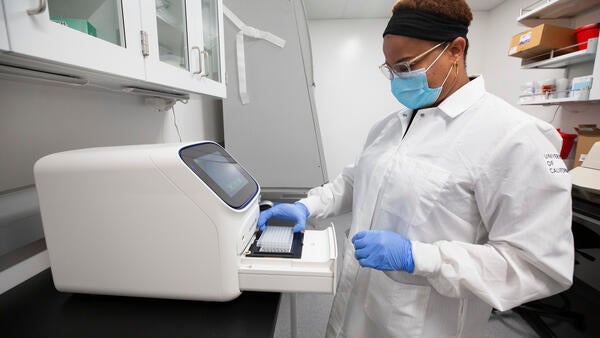COVID-19 presented UCR with many new challenges. Access to technology that allows us to continue to learn, teach, and work remotely is now a requirement rather than a convenience, and ITS is proud to have helped mobilize campus in the face of unforeseen time and resource limitations. As essential campus work and research continued, however, UCR also recognized the need to implement on-site COVID-19 testing technology.
In September ITS was engaged by Dr. Kenneth Han of Student Health Services to develop the technology required to set up sample collection sites near the student residence halls. Dr. Han was inspired by a video from the University of Illinois that showed the use of barcode scanning technology to help process samples. Former Interim CIO for ITS, David Gracey, and Lead Application Architect, Brandon Ayers, developed a proof of concept that included the ability to make the barcode scanning experience touchless to limit potential exposure to coronavirus.
Within 3 weeks, ITS was able to develop and implement the COVID-19 sample barcode scanning system. Now, when students visit a conveniently located sample collection site, they check in by scanning the kiosk QR code with their phone camera. This takes them to the testing website, where they log in with their UCR credentials. Once logged in, the website displays a code specific to the student, and the student simply points their phone screen at the kiosk scanner. The kiosk scanner reads the code, automatically populates the student’s information, and prints a label for their saliva sample. Once the oral test is administered, the labeled sample is sent to UCR’s new diagnostic lab located in the Multidisciplinary Research Building.
ITS’ Campus Support team worked closely with the diagnostic lab to ensure the effectiveness of the process. This included providing endpoint support to resolve compatibility issues with the lab instrumentation, as well as further automation to reduce manual administrative tasks.
Since implementation, ITS has continued to make process improvements based on the needs of Student Health Services and laboratory staff. For example, Mr. Ayers has created a lab interface so that the lab technicians anticipate incoming samples by viewing a list of printed labels. Additionally, ITS has developed a COVID-19 test aging report to help Housing Services track testing of campus residents. The report shows the last date a resident was tested, as well as how many residents haven’t been tested in the last 7 days. This allows for follow-up to help ensure the safety of all on-campus students, staff, and faculty.
ITS would like to recognize the campus partners who have collaborated on this groundbreaking effort. Special thanks to: Dr. Katherine Borkovich and Dr. Isgouhi Kaloshian who are leading the diagnostic lab efforts; Dr. Kenneth Han and the Student Health Services staff; the staff at UCR Health; Josh Witbeck and the staff at Residential Life and Housing Services; and the many others who contributed to this project. Lastly, we would like to recognize the ITS staff who made significant contributions to this initiative. Thank you, David Gracey, Brandon Ayers, the Campus Support and Endpoint teams, the Student Functional Support Team, the Information Security Office team, and the System Operations team.

